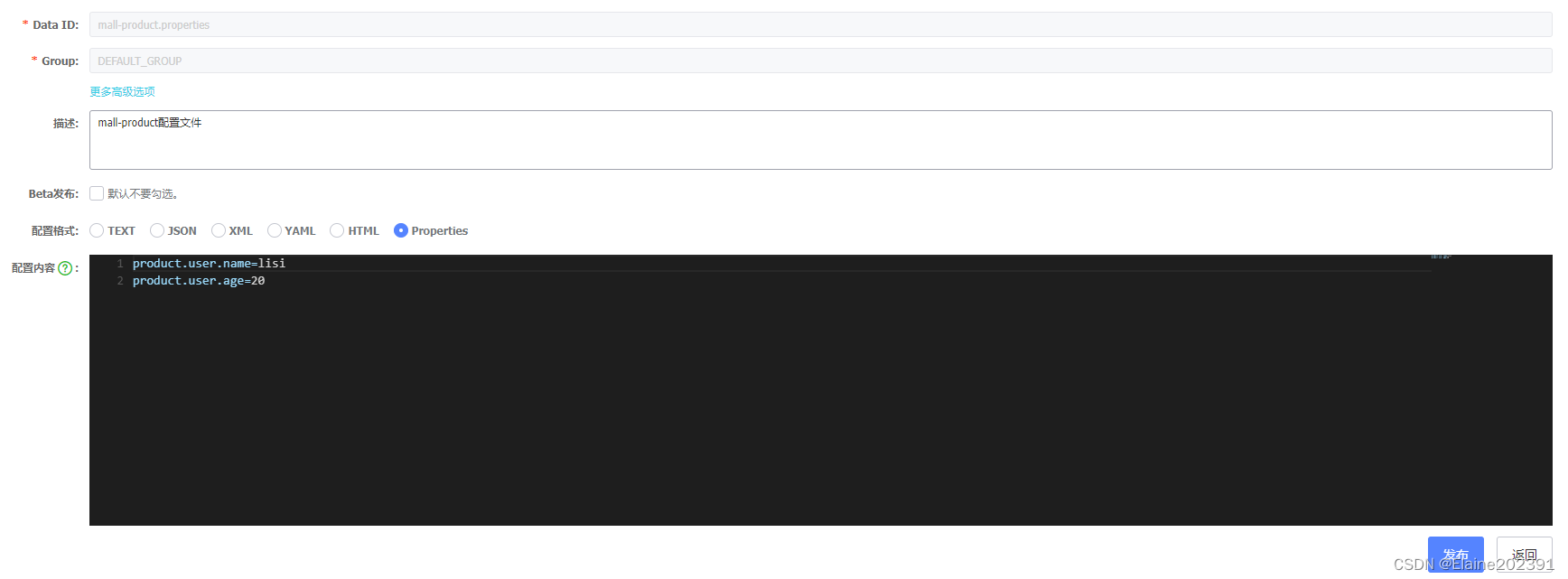目录
Nacos支持三种配置加载方案
Namespace方案
DataID方案
Group方案
同时加载多个配置集

Nacos支持三种配置加载方案
Nacos支持“Namespace+group+data ID”的配置解决方案。
详情见:Nacos config · alibaba/spring-cloud-alibaba Wiki · GitHub
Namespace方案
通过命名空间实现环境区分
下面是配置实例:
1、创建命名空间:
“命名空间”—>“创建命名空间”:

创建三个命名空间,分别为dev,test和prod
2、回到配置列表中,能够看到所创建的三个命名空间

下面我们需要在dev命名空间下,创建“mall-product.properties”配置规则:


3、访问:http://localhost:10010/product/brand/test

并没有使用我们在dev命名空间下所配置的规则,而是使用的是public命名空间下所配置的规则,这是怎么回事呢?
查看“mall-product”服务的启动日志:
2024-02-29 18:09:39.699 INFO 12828 --- [ main] c.a.n.c.c.impl.LocalConfigInfoProcessor : LOCAL_SNAPSHOT_PATH:C:\Users\Administrator\nacos\config
2024-02-29 18:09:39.720 INFO 12828 --- [ main] c.a.nacos.client.config.impl.Limiter : limitTime:5.0
2024-02-29 18:09:39.754 INFO 12828 --- [ main] c.a.nacos.client.config.utils.JvmUtil : isMultiInstance:false
2024-02-29 18:09:39.764 WARN 12828 --- [ main] c.a.c.n.c.NacosPropertySourceBuilder : Ignore the empty nacos configuration and get it based on dataId[mall-product.properties] & group[DEFAULT_GROUP]
2024-02-29 18:09:39.767 WARN 12828 --- [ main] c.a.c.n.c.NacosPropertySourceBuilder : Ignore the empty nacos configuration and get it based on dataId[mall-product-dev.properties] & group[DEFAULT_GROUP]
2024-02-29 18:09:39.768 INFO 12828 --- [ main] b.c.PropertySourceBootstrapConfiguration : Located property source: [BootstrapPropertySource {name='bootstrapProperties-mall-product-dev.properties,DEFAULT_GROUP'}, BootstrapPropertySource {name='bootstrapProperties-mall-product.properties,DEFAULT_GROUP'}, BootstrapPropertySource {name='bootstrapProperties-mall-product,DEFAULT_GROUP'}]
2024-02-29 18:09:39.772 INFO 12828 --- [ main] c.e.mall.product.MallProductApplication : The following 1 profile is active: "dev"
2024-02-29 18:09:40.359 INFO 12828 --- [ main] o.s.cloud.context.scope.GenericScope : BeanFactory id=ad80fdca-521c-30b6-a8d9-647df4fd73fe
2024-02-29 18:09:40.614 INFO 12828 --- [ main] o.s.b.w.embedded.tomcat.TomcatWebServer : Tomcat initialized with port(s): 10010 (http)
"mall-product.properties",默认就是public命名空间中的内容中所配置的规则。
4、指定命名空间
如果想要使得我们自定义的命名空间生效,需要在“bootstrap.properties”文件中,指定使用哪个命名空间:
spring.cloud.nacos.config.namespace=62ff1af4-5bf6-4ce7-9e59-f9400861c343
这个命名空间ID来源于我们在第一步所创建的命名空间

5、重启“mall-product”,再次访问:http://localhost:10010/product/brand/test

但是这种命名空间的粒度还是不够细化,对此我们可以为项目的每个微服务module创建一个命名空间。
6、为所有微服务创建命名空间

7、回到配置列表选项卡,克隆pulic的配置规则到mall-product命名空间下

切换到mall-product命名空间下,查看所克隆的规则:

8、修改“mall-product”下的bootstrap.properties文件,添加如下配置信息
spring.cloud.nacos.config.namespace=50195391-891a-4de7-accf-764482a813c0
这里指明的是,读取时使用mall-product命名空间下的配置。
9、重启“mall-product”,访问:http://localhost:10010/product/brand/test

DataID方案
通过指定spring.profile.active和配置文件的DataID,来使不同环境下读取不同的配置,读取配置时,使用的是默认命名空间public,默认分组(default_group)下的DataID。
默认情况,Namespace=public,Group=DEFAULT GROUP,默认Cluster是DEFAULT
Group方案
通过Group实现环境区分
实例:通过使用不同的组,来读取不同的配置,还是以上面的mall-product微服务为例
1、新建“mall-product.properties”,将它置于“tmp”组下

2、修改“bootstrap.properties”配置,添加如下的配置
spring.cloud.nacos.config.group=tmp
3、重启“mall-product”,访问:http://localhost:10010/product/brand/test

同时加载多个配置集
当微服务数量很庞大时,将所有配置都书写到一个配置文件中,显然不是太合适。对此我们可以将配置按照功能的不同,拆分为不同的配置文件。
如下面的配置文件:
server:port: 10010 spring:profiles:active: devdatasource:username: rootpassword: rooturl: jdbc:mysql://192.168.2.9:3306/mall_pmsdriver-class-name: com.mysql.jdbc.Driverapplication:name: mall-productcloud:nacos:discovery:server-addr: 127.0.0.1:8848 # 通用配置:mybatis mybatis-plus:mapper-locations: classpath:/mapper/**/*.xmlglobal-config:db-config:id-type: auto
我们可以将,
数据源有关的配置写到一个配置文件中:
spring:datasource:username: rootpassword: rooturl: jdbc:mysql://192.168.2.9:3306/mall_pmsdriver-class-name: com.mysql.jdbc.Driver
和框架有关的写到另外一个配置文件中:
mybatis-plus:global-config:db-config:id-type: automapper-locations: classpath:/mapper/**/*.xml
也可以将上面的这些配置交给nacos来进行管理。
实例:将“mall-product”的“application.yml”文件拆分为多个配置,并放置到nacos配置中心
1、创建“datasource.yml”,用于存储和数据源有关的配置
spring:datasource:#MySQL配置username: rootpassword: rooturl: jdbc:mysql://192.168.2.9:3306/mall_pmsdriver-class-name: com.mysql.jdbc.Driver
在mall-product命名空间中,创建“datasource.yml”配置

2、将和mybatis相关的配置,放置到“mybatis.yml”中
mybatis-plus:global-config:db-config:id-type: automapper-locations: classpath:/mapper/**/*.xml

3、创建“other.yml”配置,保存其他的配置信息
server:port: 10010 spring:application:name: mall-productcloud:nacos:discovery:server-addr: 127.0.0.1:8848

现在“mybatis.yml”、“datasource.yml”和“other.yml”共同构成了微服务的配置。
4、修改“mall-product”的“bootstrap.properties”文件,加载“mybatis.yml”、“datasource.yml”和“other.yml”配置
spring.cloud.nacos.config.extension-configs[0].data-id=mybatis.yml spring.cloud.nacos.config.extension-configs[0].group=dev spring.cloud.nacos.config.extension-configs[0].refresh=true spring.cloud.nacos.config.extension-configs[1].data-id=datasource.yml spring.cloud.nacos.config.extension-configs[1].group=dev spring.cloud.nacos.config.extension-configs[1].refresh=true spring.cloud.nacos.config.extension-configs[2].data-id=other.yml spring.cloud.nacos.config.extension-configs[2].group=dev spring.cloud.nacos.config.extension-configs[2].refresh=true
"spring.cloud.nacos.config.ext-config"已经被废弃,建议使用“spring.cloud.nacos.config.extension-configs”
5、注释“application.yml”文件中的所有配置
6、重启“mall-product”服务,然后访问:http://localhost:10010/product/brand/test

7、访问:http://localhost:10010/product/brand/list,查看是否能够正常的访问数据库

小结:
1)、微服务任何配置信息,任何配置文件都可以放在配置中心;
2)、只需要在bootstrap.properties中,说明加载配置中心的哪些配置文件即可;
3)、@Value, @ConfigurationProperties。都可以用来获取配置中心中所配置的信息;
4)、配置中心有的优先使用配置中心中的,没有则使用本地的配置。







)





,fgets(),get_s()))





